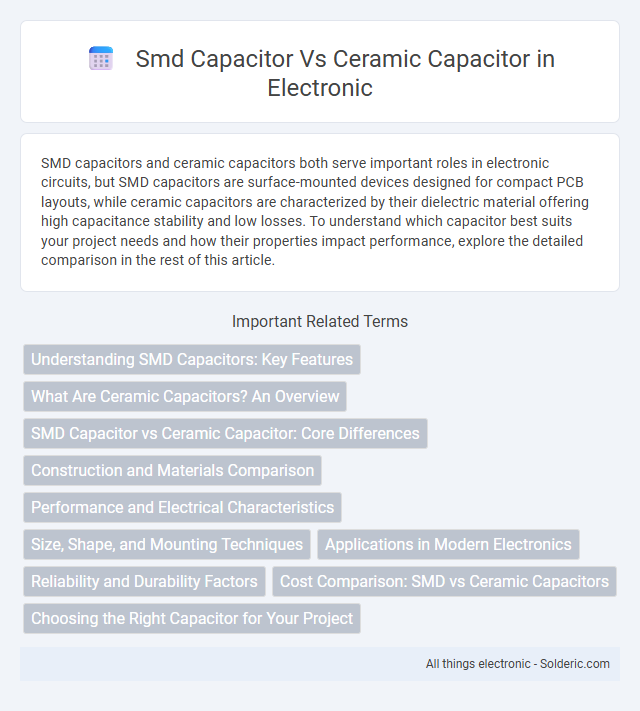SMD capacitors and ceramic capacitors both serve important roles in electronic circuits, but SMD capacitors are surface-mounted devices designed for compact PCB layouts, while ceramic capacitors are characterized by their dielectric material offering high capacitance stability and low losses. To understand which capacitor best suits your project needs and how their properties impact performance, explore the detailed comparison in the rest of this article.
Comparison Table
| Feature | SMD Capacitor | Ceramic Capacitor |
|---|---|---|
| Definition | Surface Mount Device capacitor, mounted directly on PCB surface | Capacitor with ceramic dielectric material |
| Mounting Type | Surface mount | Can be SMD or through-hole |
| Dielectric Material | Varies: ceramic, tantalum, film, etc. | Ceramic dielectric (e.g. Class 1, Class 2) |
| Size | Compact, suitable for automated assembly | Varies, generally small for SMD types |
| Applications | General electronics, RF circuits, decoupling, filtering | Decoupling, bypass, filtering, timing circuits |
| Performance | Depends on dielectric; can handle higher voltages | Stable capacitance; low ESR; limited voltage range |
| Cost | Moderate to high, dependent on material | Low to moderate cost |
Understanding SMD Capacitors: Key Features
SMD capacitors, or Surface-Mount Device capacitors, are compact components designed for automated assembly, offering high reliability and stable performance in compact electronic circuits. Unlike traditional ceramic capacitors, SMD capacitors come in various dielectric materials and shapes, optimizing capacitance and voltage ratings tailored to your device's specific needs. Their low profile and excellent frequency characteristics make SMD capacitors ideal for modern electronics requiring precise, space-efficient components.
What Are Ceramic Capacitors? An Overview
Ceramic capacitors are passive electronic components made from ceramic dielectric material, widely used for their high stability, low losses, and compact size. They are commonly available in surface-mount device (SMD) packages, which facilitate automated PCB assembly and reduce parasitic inductance. These capacitors excel in high-frequency applications, such as RF circuits and decoupling, due to their low equivalent series resistance (ESR) and self-resonant characteristics.
SMD Capacitor vs Ceramic Capacitor: Core Differences
SMD capacitors are a category of surface-mount components that often include ceramic dielectric types, making ceramic capacitors a subset within SMD options. Core differences lie in packaging and application: SMD capacitors are designed for automated PCB assembly with compact, flat packages, while ceramic capacitors specifically use ceramic materials for stable, high-frequency performance. Your choice hinges on factors like size constraints, dielectric properties, and circuit requirements, where ceramic SMD capacitors offer versatility and reliability in modern electronic designs.
Construction and Materials Comparison
SMD capacitors are typically constructed using multilayer ceramic dielectric materials stacked to form compact, surface-mount devices suitable for automated PCB assembly. Ceramic capacitors primarily utilize ceramic dielectric materials but vary widely from class 1 materials like NP0 for stability to class 2 materials such as X7R or Y5V, impacting capacitance and temperature stability. Understanding the construction and dielectric properties of these capacitors helps optimize your circuit's performance based on size, tolerance, and voltage requirements.
Performance and Electrical Characteristics
SMD capacitors and ceramic capacitors both offer excellent performance in high-frequency applications, but SMD capacitors typically provide better consistency in capacitance and lower Equivalent Series Resistance (ESR), enhancing efficiency in compact circuit designs. Ceramic capacitors excel in stability and reliability due to their dielectric materials, which deliver low losses and high insulation resistance across a wide temperature range. Your choice depends on the specific electrical characteristics required, such as voltage rating, capacitance tolerance, and frequency response for optimal circuit performance.
Size, Shape, and Mounting Techniques
SMD capacitors are compact, rectangular components designed for surface-mount technology, allowing direct placement onto PCB pads without leads, optimizing space and automated assembly efficiency. Ceramic capacitors commonly come in both SMD and through-hole versions, with SMD ceramics sharing the flat, rectangular form factor but differing in materials and dielectric properties. Mounting techniques for SMD capacitors involve reflow soldering on PCB surfaces, whereas traditional ceramic capacitors might require through-hole insertion and wave soldering, impacting production speed and board design density.
Applications in Modern Electronics
SMD capacitors and ceramic capacitors both play crucial roles in modern electronics, with SMD capacitors favored for their compact size and ease of automated assembly on printed circuit boards (PCBs). Ceramic capacitors, known for their high stability and low equivalent series resistance (ESR), are widely used in filtering, decoupling, and timing applications within smartphones, laptops, and IoT devices. Your choice depends on the required capacitance range, voltage rating, and physical footprint, ensuring optimal performance and reliability in complex electronic circuits.
Reliability and Durability Factors
SMD capacitors typically offer higher reliability and durability due to their robust construction and better resistance to vibration and thermal stress, making them ideal for modern electronic devices. Ceramic capacitors, while cost-effective and compact, may exhibit lower durability under mechanical strain and temperature fluctuations, potentially leading to micro-cracks and performance degradation over time. Choosing an SMD capacitor can enhance Your circuit's longevity and stability in demanding environments.
Cost Comparison: SMD vs Ceramic Capacitors
SMD capacitors generally offer a cost advantage over traditional ceramic capacitors due to automated manufacturing processes and smaller form factors, leading to reduced material and assembly expenses. Ceramic capacitors, while widely used for their reliability and performance, often incur higher costs in through-hole or larger sizes compared to surface mount device (SMD) types. Choosing SMD capacitors can optimize your budget, especially in high-volume electronic production requiring miniaturized components.
Choosing the Right Capacitor for Your Project
SMD capacitors offer compact size and excellent performance in high-frequency circuits, making them ideal for modern electronic projects requiring space efficiency. Ceramic capacitors provide stability and low losses with a wide range of capacitance values, suitable for filtering, decoupling, and timing applications. Selecting between SMD and ceramic capacitors depends on factors such as circuit design, operating frequency, voltage rating, and physical layout constraints.
smd capacitor vs ceramic capacitor Infographic

 solderic.com
solderic.com